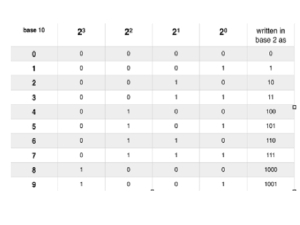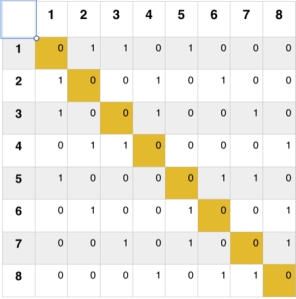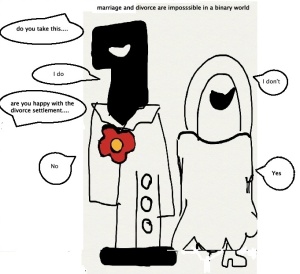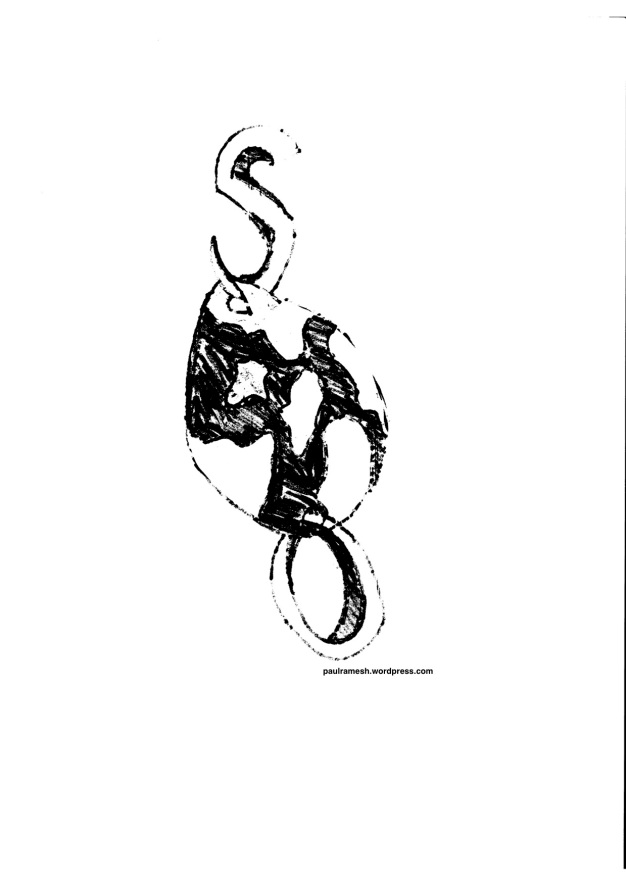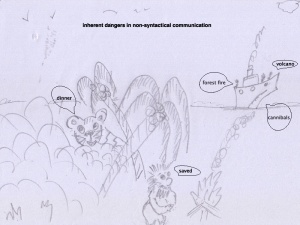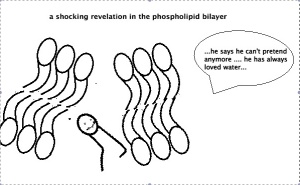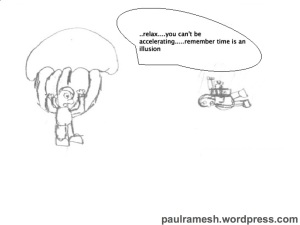Two is company
Posted by paulramesh in Uncategorized on April 30, 2017
To be or not to be….. – William Shakespeare, Hamlet.
There are 10 kinds of people in the world: those who understand binary numerals, and those who don’t.”
― Ian Stewart, Professor Stewart’s Cabinet of Mathematical Curiosities
Creatio ex nihilo.
Leibniz the famous German mathematician ( also the co-discoverer of calculus with Newton) was said to have a spiritual dimension to his relationship with numbers. he invented the binary (base 2) system which is the basis of computers and indeed the basis of all our modern telecommunication gadgets. he said that it represented the creation out of nothing (creatio ex nihilo).
The ancient Chinese text i Ching has base 2 based hexagrams and the ancient Indian mathematician Pingala used base 2 to lay down the rules of sanskrit poetry construction.
What does base 2 mean?
We are familiar with using numbers from 1-9 (base 10 system) – no doubt because we can relate to it as it is the same as the number of fingers we posses. Just as we have no new number to represent anything beyond 9. We represent 10 by reverting to putting 0 in the ones place and 1 in the tens place.
Another way of describing the base 10 system is to say – units as 10 power 0, tens as 10 power 1, and hundreds as 10 power 3.
The same can be done with base 2
All our computing devices, computers, smartphones etc use the base 2 system.
Computers are built of many circuits using semiconductors – information supplied to it takes the form of current flows (1) or does not flow (0)(usually a higher voltage and a lower voltage) that can be stored and retrieved.
At its very heart this forms the basis of all computing of the modern era. the advantage is that even when distortions of the signal occur – ‘noise’ which can distort the information as in an analogue system the damage is limited in computers as the key information is conveyed in only one of two possible states – current on or off.
Binary numbers and geometrical objects.
Solid geometrical shapes can be represented using the binary system.
Here is an example of representing a cube using the 1’s and 0’s.
Take a cube and designate its corners as numbers 1-8.
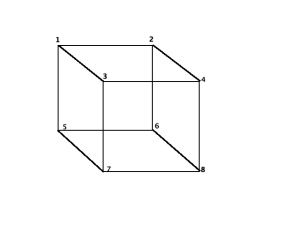
Build a matrix and if the 2 numbers are connected by a line then give number 1 – if no connection exists then give the number 0.
the numbers are a mathematical representation of a cube.
Line 1 is a mirror image of line 8.
The numbers above the diagonal are mirror image of the numbers below the diagonal.
There are a number of mirror symmetry that becomes apparent when you view the resulting matrix.
The binary code in medicine.
Any event, signalling, cell death etc can in theory be regressed to a series of happens and does not happen and complex mathematical models can be made to study and understand them better.
this is the field of binary biology and is being used among other areas in cancer biology to predict the behaviour of cancers and treatment outcomes.
Blow Hot to Cold
Posted by paulramesh in Uncategorized on May 27, 2016
You must learn all things, both the unshaken heart of truth, and the opinions of mortals in which there is no warranty. Parmenides – Greek philosopher early 5th century BCE
Out, out, brief candle! . William Shakespeare, Macbeth, Act 5 Scene 5.
A spacetime obeys Einstein’s equations because the atoms of spacetime maximize the entropy—just as a gas obeys gas laws because the atoms of gas maximize its entropy. Thanu Padmanabhan, Theoretical Physicist
Space is in the first place a device introduced to describe the positions and movements of particles. Space is therefore literally just a storage space for information. This information is naturally associated with matter.
Starting from first principles, using only space independent concepts like energy, entropy and temperature, it is shown that Newton’s laws appear naturally and practically unavoidably.
Gravity is explained as an entropic force caused by a change in the amount of information associated with the positions of bodies of matter. Erik Verlinde.
Self-replication is a capacity common to every species of living thing, and simple physical intuition dictates that such a process must invariably be fuelled by the production of entropy. Jeremy England
If you are a minimalist and wondered about what was the most basic force. that made the universe and everything in it – what would be your choice?
I have come to the conclusion (for now) that it appears to be temperature (thermodynamics).
To physicists this may be second nature – but for me it is was a little difficult to absorb.
This post is for people like me to at least vaguely appreciate so profound a creation wrought by differences in temperature
There are some interesting facets about temperature and another fundamental property of nature – time.
Both are relative ( they can be defined only by comparison)
time is faster or slower than a defined interval between two distinct events
Temperature is defined by a scale from hotter to colder or vice versa of one body compared to another body or to itself at a different point in time.
They both (appear to) have an upper limit and a lower limit in our observable universe.
The speed of light is the fastest and Planck’s time the slowest possible in our universe.
Temperature has an absolute zero (0K =-273C) at which temperature the macroscopic motion of the atoms or molecules is minimum or effectively zero and a theoretical possible high – an absolute hot – Planck’s temperature – 1.41 X 10³² K. Indeed there is a temperature scale called Plancks scale that has absolute zero as O and absolute hot as 1.
At this temperature the current conventional standard model of physics can no longer explain what is going on.
At just a breezy 10¹ºK electrons are nearly at the speed of light, at 10³² K the energy they acquire is so large that they become extremely dense and each particle will form its own black hole – so absolute hot is the maximum temperature at which matter as we know it can exist.
In the earliest phase of the Big Bang the universe did experience this temperature – since all parts of that early universe where at the same temperature no energy exchange may have been possible. Ironically the same thing happens when every part of the universe becomes the coldest possible – no energy exchange happens. So a temperature (thermodynamic) gradient has to exist for things to happen – events to happen – even for time to exist.
If you had a maximally disordered universe – complete chaos – maximum entropy – no two events can be predicted – NO CLOCK IS POSSIBLE
In a completely still universe where every movement is stopped, atoms don’t move or rotate or vibrate.
even subatomic particles can’t or don’t exchange energy – no two distinct events are discernible – no time interval can be defined – NO TIME IS POSSIBLE
So there is a trade off between these 2 extremes (trade off is a feature that is central to physics, chemistry and especially biology) in our universe making time and us possible.
Temperature (I use this interchangeably with thermodynamics) gradients make things possible.
Movement and temperature and time
The phenomena of time dilation is familiar to all science fiction buffs – as you accelerate towards the speed of light – time slows down compared to a stationary observer.
Not so commonly known is the Fulling-Davies-Unruh effect which postulates that if you carried a thermometer and accelerated through the vacuum it would register a higher temperature than someone who was stationary. Imagine that – your friend and you have bought cold coffee and if she stays at the coffee shop and you have accelerated through a vacuum with no outside temperature just your acceleration relative to her, it will heat up your coffee but not hers. This is due to non zero fluctuations in the ground state of a vacuum that become more pronounced to the accelerating person compared to the stationary observer to whom the temperature of the vacuum would remain at zero.
So acceleration is intimately connected to time and temperature.
Energy and temperature
Wavelengths of the electromagnetic waves signify energy. shorter wavelengths are associated with higher temperatures. The corollary is that as bodies approach absolute zero the wavelength approaches infinity, and as it approaches Planck’s temperature the wavelengths approach Planck’s length.
Temperature and you
There is a temperature range for functioning of our bodies. The normal is 37C. The range that humans can tolerate without immediate medical management is 35-45C, at both these extremes death soon follows without intervention.
The coldest I have cooled a person for the purpose of operating on the inside of their blood vessel is 16C, a lot of support is required to bring these patients back to life.
Energy has to be supplied within a range and at a given rate for it to be useful – too little, too much, too slowly or too fast are all harmful.
Things can happen (work can be done) only as energy flows from higher temperature to lower temperature.
As the heat of the sun pours out into the cold of space – earth harnesses that energy (actually a very small proportion of it ) to make life.
As the heat of the Big Bang flows toward the cold of the final Big Freeze – our universe unfolds in its wake as a consequence.
The unseen hand behind both is the same force – thermodynamics.
Thermodynamics of a living cell.
Life is defined as metabolism and self replication. If an entity can harness energy and use it to construct itself and self replicate it is alive.
Irrespective of which came first they both are manifestations of energy transfer.
The food you eat is stripped of its energy and that is cascaded down an energy extracting staircase – the electron transport chain – which takes the energy captured converting it into a force (the proton motive force) that helps make ATP – which is what keeps you alive and helped kickstart life.
Jeremy England has calculated the entropy of self replication setting the stage to study life and natural selection through the prism of thermodynamics.
Will temperature be the last force standing?
It is possible that gravity, space and time may all be emergent phenomena from thermodynamics which may be the one force to rule them all.
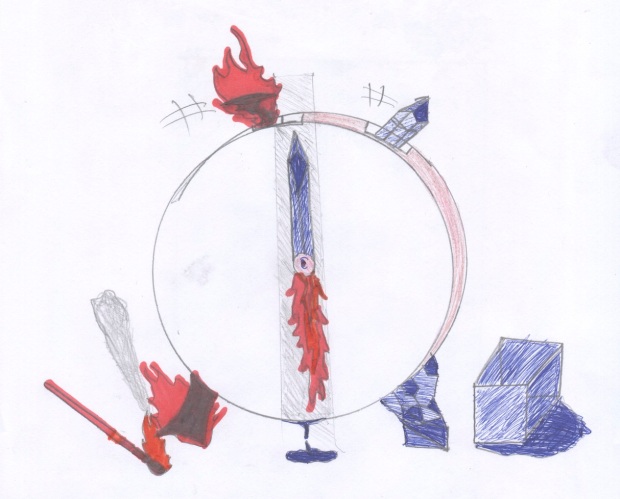
Image courtesy – Siddharth Paul
Further reading:
Grappling with gravity
. Thanu Padmanabhan – Scientific American Jan 2011
On the Origin of Gravity and the Laws of Newton
. Erik Verlinde – arXiv:1001.0785v1 [hep-th] 6 Jan 2010.
Statistical physics of self-replication.
Jeremy England -The Journal of Chemical Physics 139, 121923 (2013)
It’s only words
Posted by paulramesh in biology, cartoon, evolution of language, general scientific interest, language, language and emotions, science blog, words on November 13, 2014
One touch of nature makes the whole world kin – William Shakespeare
It’s only words but words are all I have – Barry Gibb
“Meow” means “woof” in cat.” – George Carlin
Language is the most important evolutionary invention of the last few million years. Natural selection can only see the advantages of syntactic communication if the size of the system is above a critical value. – Martin Nowak.
As I write this post the European Space agency is attempting to land a probe on a comet. This easily ranks as one of mankind’s greatest achievements to date. It would not have been possible if our ancestors had not discovered the use of words.
Language has transformed humans and in turn the planet. It has set us distinctly apart for our closest cousins the apes.
Some biologists rank the evolution of language skills on par with the formation of RNA, the first cells and the evolution of multicellular life.
Language makes communication, effective, is unparalleled as a form of passing on survival advantages from generation to generation without the help of genes . In short it is the reason for civilisation. without it we would be no better off today than our hominid ancestors.
How could noises in the throat, grunts etc have evolved into the complexity of present day language?
Language is a trait that needs many different things to have happened.
The vocal cords and associated muscles, the palate, the upper aero-digestive tract (pharynx and larynx ), the tongue etc. had to change in structure and orientation to each other. The brain had to develop a neural circuitry to both create and understand language.Language is a biological creation and as such it obeys the laws of biology. It evolves, it can flourish, it can mutate and it can go extinct just like any species.
There was a time when our ancestors could not speak and then they could – what happened?
Monkey hear but monkey cannot do
If you trace our ancestry after we split from a common ancestor with the chimpanzee, what we do know from the fossil record is a non linear trajectory to us through Australopithecus (2-5million years ago: brain volume – appx 400cc), Homo habilis, Homo erectus (about 1-2million years ago: brain volume appx 600cc) and then Neanderthals alongside early Homo sapiens (brain volume 1200-1500cc).
The fossil record has been studied for what has been called the supralaryngeal airway configuration. this is a description of the physical structure of the space in the throat that is important for voice production.
There appear to be 2 versions of throat architecture
the standard plan – that is the basic configuration in monkeys, apes etc and the human version.
The next time you drink something quickly or eat in a hurry and feel a choking sensation and start coughing remember its a small price to pay for human civilisation – thats right I am not exaggerating.
The mouth, tongue, palate, nostrils, the epiglottis, the larynx (voice box) with its vocal cords and the pharynx together help you breathe and swallow food and drink. They are the composite organ for voice production as well.
The larynx is high up in the throat in all apes and indeed in new born human babies. This helps the epiglottis approximate the soft palate and ensures a patent airway is formed to deliver air to the trachea and lungs even when the animal is drinking. The fluid tracks from the mouth to the sides of the larynx and into the pharynx and the upper gullet (oesophagus). Hence apes are obligate nose breathers. They can continue breathing even while feeding. This is also the case with new born human babies – as they suckle they can continue to breathe – if they could not they would get breathless after small feeds or choke every time they fed – NOT a useful survival strategy.
In human children the larynx descends lower down and the posterior 1/3rd of the tongue also is in the upper throat by about 2 years of age.
Many aspects of the upper aero-digestive tract have been studied and quantified in hominid fossils and apes. One remarkable measurement is called the basicranial line. It is an imaginary line drawn from the tip of the nasal bone through the palate to the base of the skull. It denotes the angle the base of the skull makes with upper airway. Only adult humans among the primates have an angle of 125 degrees.
This angle is much less flexed about 134-137 degrees in all primates and early hominids and indeed in new born babies. This is as a consequence of descent of the pharynx and the new origin of the muscles of the pharynx.
The ability of apes to approximate their ‘voice box’ to the back end of the nose – although excellent for drinking and breathing and swallowing without fear of choking – is not conducive for producing vowel sound that are so central to language. Talk is not cheap. it comes at a price.
The average vocabulary of some like you reading this post is about 50,000 words. it is estimated that until the age of 16 we learn a new word every one and half hours that we are awake.
words are sounds strung together, sentences are words strung together. The agreed upon sequence of words in a sentence is the syntax and grammar of a language. It appears that newborns get about 90% of the grammar right from the word go – it appears innate rather than taught.The voice box is just a tool to produce the sounds, language is more than that. It is intricately connected to learning, memory and even emotions. So the real action is happening in the brain.
When you see something and call out its name the following takes place:
The eyes have captured the light reflected off the object and they have relayed a signal to the visual centres of the brain, these in turn send the impulses to a part of your temporal lobe called Wernickes area (area 22) which tries to understand the visual image it has received and then relays this information (via a band of neurone called the arcuate fasciculus) to another region of the brain in the frontal lobe called Brocas area (area 44). This area co-ordinates and prepares to vocalise this information. It in turn coordinates with the motor cortex and makes your vocal cord, tongue, lips etc move and vibrate the air to produce a collection of sound waves which are heard as the word.
It is fascinating fact that when you learn a second language as a child both languages are represented in a single area in the brain whereas when you learn a second language as an adult it is represented as a separate albeit adjacent area of the brain.
Before the Tower of Babel
Many linguists believe there is an underlying grammar and syntax that is common to all languages. That is there was descent and modification, reflecting local needs that led to the plethora of languages. If that is true then much like life has a as yet hypothetical Last Universal Common Ancestor (LUCA), there may well be a common first language to all mankind now lost in the mists of time.
It is all in the mind
These areas of the brain can get damaged (from a stroke or head injury) and produce disorders of language. The disorders are called aphasias. There are many forms – damage to the Brocas area can lead to a person having very few ( rarely only the last words uttered at the time of injury) words at their disposal to describe everything. This is called non-fluent aphasia. Damage to the Wernickes area – can sometimes make the person talk a lot, but they may speak gibberish indeed invent new words (neologisms) that have no meaning. This is called fluent aphasia.
Usually strokes or trauma leads to extensive damage and both understanding(receptive) and communication (expressive) aspects of language are lost.
Sometimes when deaf people have damage to language areas they lose the ability to communicate via sign language.
Animals communicate via sounds that convey whole events , e.g a monkey call for snake on the ground, or tiger nearby. This is non syntactic communication. Words on the other hand can be strung into almost limitless combinations (sentences) to convey any number of things – this is syntactical communication of humans – this represented (according to some biologists) a survival advantage that made up for inherent physical weakness over other animals and maybe even Neanderthals.
Language and emotions. (‘the lunatic, the lover and the poet are of imagination all compact ‘)
Jablonka et al. have argued that there has been a coevolution of emotions and language. The most basic ‘fight or flee’ response is usually set in motion by disturbances in the herd, danger calls or visual sighting of the predator. But if a tribe is on the move and is told that there is a tiger that lives about 4 miles away – a flight response at that second becomes meaningless.
This in turn leads to inhibition of the fear response or a more complex modulation of it. This may in turn have helped us evolve complex and new emotions – defining us as human.
Words help us share experiences creating increased empathy, words can alter reality, true and false as a concept is enhanced by language – i.e. what was said and what was seen are different. They can stimulate our imagination for things which we or indeed no one else has experienced. It in a word elevates us above the mundane.
Words introduced humans to humour. Dialogue meant not every aggression needed to end in a bloodbath. Abstract concepts can be conveyed by words as well as love, fear and happiness.
Words, like the people that use them are born, live and die . The advent of writing immortalised words, transmitted knowledge wholesale (unlike genes that could transmit to only the next generation) to succeeding generations, indeed all mankind.
The collective strength of humanity went up manifold. The result is everything you see before you today – if it was not for words we may still be in the Stone age.
Martin Nowak has described the mathematical models that describe the principles of language evolution. He asserts that for syntactical communication there is a threshold population size necessary beyond which natural selection will favour rapid language development.
The Information technology revolution is in a sense the rapid transmission of language in all forms thus enhancing its value. Words hold the key to our future.
To paraphrase the Bard (whose mastery over words is unparalleled) to describe the beauty of language.
Age cannot wither her, nor custom stale
Her infinite variety: other (human traits) cloy
The appetites they feed: but she makes hungry
Where most she satisfies;”
Therefore it is true to say that though humans made language it is language that made us truly human.
Further Reading
Nowak MA. Evolutionary biology of language.
Phil. Trans. R. Soc. Lond. B (2000) 355, 1615-1622.
Liberman P. The Biology and Evolution of language
Chapter 12, 1994. Harvard University Press.
Jablonka et al. The Co-evolution of language and emotions.
Phil. Trans. R. Soc. B 2012 367
The light of your life
Posted by paulramesh in Uncategorized on October 23, 2014
Every new beginning comes from some other beginning’s end. - Seneca
…..What light through yonder window breaks? – William Shakespeare
Life is a process of harnessing energy. – William F. Martin
Everything has to start from somewhere.
Indeed life is about harnessing energy and making complex molecules out of simple ones . The complex molecules have properties that carry out different functions. The evolution of life is in one sense the evolution of molecules and their complexity and stability.
Stars spew out many elements – interstellar space, comets contain a variety of molecules, however to get from these simple molecules to complex organic molecules and then life appears a stretch.
Our sun radiates an enormous amount of energy – this is lost in the cold of space. earth has managed to capture some of the energy and sequester it to perform the magic of life.
Electric discharges, ferridoxin (the iron-sulfur world), UV light are some of the contenders as to the energy source.
Let us consider only UV light in this post.
Beguiling light
We had seen (please see blog on light /https://paulramesh.wordpress.com/2014/02/ that different wavelengths of light have different energy – the shorter the wavelength, the higher the frequency the greater the energy.
Early earth (about 4 billion years ago) had not much of an atmosphere to speak of, UV light penetration was much higher than today.
When a photon with an energy level that is just right to excite an electron to a higher orbit came along the electronic configuration of that molecule or element changed and the possibility of newer molecules being created increased.
But which molecule and why?
First among equals or the only man for the job
There are a few molecules in contention, but foremost among them is formamide (CH3NO). it can be synthesised from carbon monoxide and ammonia (themselves found throughout universe). Formamide has been identified in comets.
Whether the original formamide that kickstarted life was from outer space or made here on earth, it has certain features that make it a prime contender for the title precursor molecule of life.
It is one of the simplest molecules to have a peptide bond. This is a bond between the Carbon and Nitogen parts of the molecule and is a hallmark of molecules called amino acids that form proteins and hence life. NO PEPTIDE BOND, NO AMINO ACID , NO LIFE AS WE KNOW IT.
Formamide has been studied in great detail. It can be joined up in series to give more complex molecules including nucleic acids the forerunners of RNA and DNA.
Just heating them up can lead to complexity, but some of the reactions can take very long or use a lot of energy.
Lets get this party started
One method by which the process could be kickstarted easily and maintained is photocatalysis. indeed heat with UV irradiation yielded both different kinds and increasing quantity of nucleobases (eg. adenine, guanine, hypoxanthine , etc.).
Even with an energy source as powerful as UV light – organic chemical reactions can be notoriously slow. the presence on earth of materials (transition metal oxides eg. titanium dioxide) would facilitate the transfer of energy from UV to the reactants such as formamide.
The energy provided by the combination of UV light and photocatalysts was a sustainable source of energy that molecules like formamide used to string themselves into more and more complex polymers.
The molecules that were most stable survived and more of them accrued – this also accounts for the fact that very few types of molecules are at the basis of all life.
Formamide. formamide everywhere….
Formamide is dipole like water and is an excellent solvent. https://paulramesh.wordpress.com/2014/01/05/water-nectar-of-the-gods/
It can be concentrated quite easily by evaporation. It has been flagged up as a potential alternative to water for extra-terrestrial life forms.
Just starting out with formamide ( or even with carbon monoxide, ammonia, water and hydrogen cyanide) with a few transition metal photocatalyst and a planet surface with incident UV light brings us quite quickly to all the molecules required for life.
Old solutions for new problems
Photocatalysis is also the mechanism that is being increasing investigated to help produce clean fuel in the form of hydrogen from water. The oldest mechanism that may have helped start life may well be the solution to one of the biggest current problems on earth.
Further reading
1. Martin WF et al. Hydrogen, metals, bifurcating electrons, and proton gradients: The early evolution of biological energy conservation.
FEBS Letters (2012)
2. Saldino R et al. From the one-carbon amide formamide to RNA all the steps are prebiotically possible.
Biochimie 94 (2012)
3. Senanayake SD et al. Photocatalysis and the origin of life: Synthesis of nucleoside bases from formamide on TiO2(001) single surfaces.
PNAS (2006)
4. Jones BM, Mechanistical studies on the production of Formamide (H2NCHO) within interstellar ice analogs.
The Astrophysical Journal (2011)
5. Barks HL et al. Guanine, Adenine, and Hypoxanthine Production in UV-Irradiated Formamide Solutions: Relaxation of the Requirements for Prebiotic Purine Nucleobase Formation.
ChemBiochem (2010)
Border security force
Posted by paulramesh in Uncategorized on August 2, 2014
Like all walls it was ambiguous, two faced. What was inside it and what was outside it depended upon which side you were on.
―Ursula LeGuin The Dispossessed.
Without the lipid bilayer we would have no physical shape. In fact, we would be little more than a puddle of chemicals on the floor.
– Crowe, Bradshaw, Monk, Chemistry for the Biosciences – The essential concepts
Love and hate in equal measure
In probably one of the most important divisions between oneself and the other is the definition of the cell and its external environment.
The physical structure that makes this distinction is the cell membrane.
How does the cell membrane divide the inside of the cell from the outside?
Our bodies and our cells are effectively made up mostly of water. The most likely place for the origin of life is an aqueous environment.
One of the most important properties of water is its polarity. for details please see the blog on water – nectar of life.https://paulramesh.wordpress.com/2014/01/05/water-nectar-of-the-gods/
At its most basic structure the cell membrane is described as a lipid bilayer.
The organic molecule that constitutes the cell membrane is called glycerophospholipid. It has a carbohydrate part called glycerol, a fatty acids part and a phosphate and protein part.
The phosphate part is polar in nature. This means that it interacts well with water, which in turn means that it forms hydrogen bonds with water. This part of the molecule is called hydrophilic which means water loving.
The fatty acid part is set to be non polar in nature. This means it does not interact with water to form hydrogen bonds and indeed leads to disruption of the hydrogen bonds that exist between water molecules.
In order to preserve stability of molecule and water, the the water loving part orients away from the water hating part. The molecule in effect folds and aligns in such a way that the water loving part faces the water (the hydrophilic head) and the water hating part lies together away from the water (the hydrophobic tail).
This is also the reason why oil and water do not mix.
This is the basis for the lipid bilayer of the cell membrane .http://www.occc.edu/biologylabs/Images/Cells_Membranes/plasmamembrane2.jpg
Customs and immigration
The primary function of the plasma membrane is similar to a border security force. It regulates what can get into the cell, and how much of it, what can get out of the cell. It is a dynamic and complex structure – not just a barrier.Cholesterol – which has over the years gained a bad reputation in health matters – is an integral part of the membrane – indeed it is vital for its function and is found inserted between the lipid bilayer.
The cell membrane is a very fluid structure and is far more than just a bilayer and cholesterol. There are protein structures that traverse its length – the integral proteins, they were thought to move like icebergs in a lipid sea. it is now believed that the movement is not random but goal directed.
Molecules can pass into and out of a cell in a variety of ingenious ways.
- Simple diffusion – certain small uncharged molecules have a green channel and can just go across the membrane provided their concentrations inside the cell are lower.
- Some have to be transported across the membrane via carrier proteins, the molecule gets onto a defined integral protein that changes shape and carries it to the inside of the cell. If this process requires energy – it is called active transport such as for hydrogen ions as they have to be carried against their concentration gradient , if no energy is required e.g.. Glucose it called passive transport.
- Ion selective channels – here the protein is specific for the ion that it will transport into the cell, it is controlled by electric potential (voltage gated), chemical transmitters (ligand-gated), mechanical stress (mechanical gated e.g. in the ear) and light see blog on light.
- The integral proteins can be receptors for hormones – so the arrival of a hormone can induce changes in the receptor and trigger changes on the inside of a cell and thus control its function.
- They can be enzymes that catalyse reactions at the membrane or inside in response to stimuli
- They also link the internal scaffold of the cell (the cytoskeleton) to the external scaffold ( the extracellular matrix). the complexities of this relationship are only now being studied in detail.
- Molecules can be transported inside by the cell membrane just engulfing and ingesting them – endocytosis. this happens to bacteria when they are attacked by your immune cells.
- The products of say an endocrine gland may need to be extruded outside the cell into the blood stream for it to act elsewhere – this is done by the cell membrane that spits out the vesicle contacting the hormone by a process called exocytosis
The membrane has other functions to anchor the cell to the next cell, to the scaffold and move it around when necessary.
Them and Us
One of the essential difference between bacteria and us is in the way the cell membrane is configured.
The bacterial cell wall endows it with a capacity to sometimes evade our surveillance, be harmful to us and indeed one of our weapons ( an increasingly obsolete one ) is to target the destruction of the bacterial cell wall with chemicals ( antibiotics).
The breakdown of the defences of our barriers especially in the intestine against our most ancient foe (and friend) leads to one of the most catastrophic clinical situations known to medicine – the sepsis syndrome (later in detail).
Two is company
Posted by paulramesh in cartoon, general scientific interest, geometry, mathematics, medicine, science blog on July 20, 2014
To be or not to be….. – William Shakespeare, Hamlet.
There are 10 kinds of people in the world: those who understand binary numerals, and those who don’t.” ― Ian Stewart, Professor Stewart’s Cabinet of Mathematical Curiosities
Creatio ex nihilo.
Leibniz the famous German mathematician ( also the co-discoverer of calculus with Newton) was said to have a spiritual dimension to his relationship with numbers. he invented the binary (base 2) system which is the basis of computers and indeed the basis of all our modern telecommunication gadgets. he said that it represented the creation out of nothing (creatio ex nihilo)
The ancient Chinese text i Ching has base 2 based hexagrams and the ancient Indian mathematician Pingala used base 2 to lay down the rules of sanskrit poetry construction.
What dose base 2 mean?
We are familiar with using numbers from 1-9 (base 10 system) – no doubt because we can relate to it as it is the same as the number of fingers we posses. Just as we have no new number to represent anything beyond 9. We represent 10 by reverting to putting 0 in the ones place and 1 in the tens place. Another way of describing the base 10 system is to say – units as 10 to the power 0, tens as 10 to the power 1, and hundreds as 10 to the power 3.
The same can be done with base 2
All our computing devices, computers, smartphones etc use the base 2 system.
Computers are built of many circuits using semiconductors – information supplied to it takes the form of current flows (1) or does not flow (0)(usually a higher voltage and a lower voltage) that can be stored and retrieved.
At its very heart this forms the basis of all computing of the modern era. the advantage is that even when distortions of the signal occur – ‘noise’ which can distort the information as in an analogue system the damage is limited in computers as the key information is conveyed in only one of two possible states – current on or off.
Binary numbers and geometrical objects.
Solid geometrical shapes can be represented using the binary system. Here is an example of representing a cube using the 1’s and 0’s. Take a cube and designate its corners as numbers 1-8.
Build a matrix and if the 2 numbers are connected by a line then give number 1 – if no connection exists then give the number 0.
The numbers are a mathematical representation of a cube*.
* adapted from Max Tegmark – Our Mathematical Universe
Line 1 is a mirror image of line 8.
The numbers above the diagonal are mirror image of the numbers below the diagonal.
There are a number of mirror symmetry that becomes apparent when you view the resulting matrix.
The binary code in medicine.
Any event, signalling, cell death etc can in theory be regressed to a series of happens and does not happen and complex mathematical models can be made to study and understand them better. this is the field of binary biology and is being used among other areas in cancer biology to predict the behaviour of cancers and treatment outcomes.
The War within Worlds
Posted by paulramesh in biology, cartoon, general scientific interest, medicine, science blog on April 20, 2014
A half remembered nightmare
Posted by paulramesh in Uncategorized on April 1, 2014
The wise are instructed by reason, average minds by experience, the stupid by necessity and the brute by instinct. – Cicero
The very essence of instinct is that it’s followed independently of reason. –Charles Darwin
I have begun to listen to the teaching my blood whispers to me. –Hermann Hesse
Two of the worst disasters of the 21st century (so far) were the 9/11 Twin Towers terrorist strike and the tsunami of December 2004. Of the many stories that emerged the following two were remarkable.
The first (related to 9/11) was that only 4 people in the floors above where the planes crashed had survived. They did this by not heeding the advice (given by the authorities) not to proceed down the Stairwell A through the smoke and debris but to go to the floors above. http://usatoday30.usatoday.com/news/sept11/2001/12/19/usat-escape.htm
The second was that during the tsunami, certain ‘stone age’ tribal people of the Andaman Islands had at the first tremors moved to higher ground. The more ‘modern’ tribal people of the Nicobar Islands perished in large numbers. http://news.nationalgeographic.co.in/news/2005/01/0125_050125_tsunami_island.html
In both cases they survived because they trusted their instincts.
Instinct is a subconscious patterned behaviour response to stimuli. It is not under the control of the will. It is conserved (not lost by evolution) in nature, as it is life preserving. But where did it come from?
The origins of instinct
During the Cambrian period the prey predator relationship was getting established. The top predator of this period was Anomalocaris. Evolutionary pressure would have favoured prey that was able to recognise early on, the presence of a predator. Even a split second difference in identifying a predator would have conferred an advantage. In time this trait would have become hardwired into the neural system. This was most likely the origin of instinct.
The Scorpion King
Jaekelopterus rhenaniae http://news.nationalgeographic.co.in/news/2007/11/071121-giant-scorpion.html
About 390million years ago, in the shallow coasts of ancient seas and in brackish fresh waters there lurked a true monster. It was an animal related to present day spiders and scorpions. It grew to an incredible length of over 8 feet. it was found all over the world. It most likely ambushed and hunted our marine ancestors – fish. Fish that could detect its presence early on survived and passed this trait onto its progeny. The fact that the trait was so important meant it did become an intrinsic part of fish brain and passed down the ages to us.
The sum of all fears
The fear circuits of the brain – honed over hundreds of millions of years – are the basis of all instinct. Their remnants in our brain today – devoid of the environmental context in which they were created – appear as anxiety, panic attacks and phobias.
When confronted by a potential threat, the organism has to make a choice – fight or flee. But in that instant before it does it has to ascertain whether the threat is real or a false alarm. Both fighting and fleeing are energy intensive and in energy poor conditions may be fatal to the animal if it continually overreacts to potential threats. Threat perception is highly evolved as it confers a significant survival advantage. Instinct is an integral part of threat perception and helps the animal make that split second decision that may lead to life or death.
Bracha* introduced (in 2006) the elegant concept of ‘Neuroevolutionary time depth principle’.
It reaches back in time to our evolutionary past and teases out the relationship between our ancestors and their environment and attempts to ferret out the causes of a variety of current mental disorders.
Simply put it means we are a product genetically, physically and mentally (both emotionally and cognitively) of all that went before us.
The fear circuits that we share with all mammals were laid down in our ancestor brains in the Mesozoic era (around 140 million years ago).
The fear circuits that we share only with our monkey and ape cousins were laid down in the Cenozoic era (around 20 million years ago). There are others more recent that we share with our Stone Age brethren and some only with those from our cultural background.
Fear of heights
Both human toddlers and one day old goats having had no previous experience or learning of the dangers of heights demonstrated a clear fear of heights. This trait is hard wired into the brain of all mammals. Indeed fear of heights is the norm. It is also intriguing that skyscraper workers – who must in some sense have lesser fear than the rest – appear to have the trait (of not being bothered by heights) run in their families.
Separation anxiety
Mammalian children have less survival skills soon after birth compared to their reptilian counterparts. They need the protection of their mother and their social group. getting separated from the group could mean death. Separation anxiety is a trait unique to mammals and marsupials and is absent in reptiles. Reptiles tend to care for their young much less intensely and certainly for much shorter duration. The maternal instinct is far more developed in mammals and has contributed directly to the success of mammals.
Fear of snakes
Fear of snakes permeates the history of mankind. From Hinduism to Judeo-Christianity and Mesoamerican religions, the snake is in turn both worshiped and reviled. It pervades our subconscious. Any number of studies attest to the fact we fear it more than (exponentially greater) threats such as automobiles. Where does this deep-seated fear come from and why?
A Simian Garden of Eden.
One of the most fearsome predators that our simian ancestors faced (some 100million years ago) was constrictor snakes. If you feel that the average python or anaconda does not really scare you, take a look at one of the ancient constrictor snakes discovered in 2009. It is called Titanoboa and it was 42 ft. in length and weighed well over 1tonne. http://www.nature.com/news/2009/090204/full/news.2009.80.html
In keeping with the Red Queen hypothesis https://paulramesh.wordpress.com/2014/03/21/hey-jude-dont-be-afraid/, the visual cortex of our arboreal monkey and ape ancestors kept evolving to better track their predator. Our monkey ancestors usually fled from their predators by climbing trees, unfortunately snakes could as well. Thus our ancestors in the late Cretaceous were very wary of snakes. There was constant evolutionary pressure to better detect snakes.
About 35-50million years ago, the situation worsens with snake evolution having created venomous snakes. These are typically smaller and more difficult to see in the foliage. The visual cortex also continues to evolve – the eyes become supreme detectors of snakes – trichromatic vision, depth and shape perception of the highest degree. The numerous connections to and fro from the amygdala (the fear centre) means that threat perception from snakes or even snake–like objects are processed instantly. Recent evidence suggests that this information may reach the fear circuits via pathways that bypass the primary visual cortex. Even before you know you have seen a snake the brain takes evasive action.
Hail to the snake god – for making us human
All of this means that our primate ancestors now possess a huge cortex- and most of it devoted to visual processing – the numerous connections to and fro from emotional centres of the brain, lead to an ever increasing complexity of seeing and interpreting not just snakes, but the world at large. In addition social skills improve – as a result of needing everyone’s eye on the job of detecting snakes. It makes them smarter and stronger – a clear cut biological advantage.
The stage is set for that giant leap in anthropoid evolution – a journey that leads directly to us and the world today. In such a compelling and dangerous environment was forged our intelligence.
Could it be then that all of humanities achievements are the culmination of a process that was kick started by fear of snakes in the Cenozoic?
Fear of darkness
The eyes can detect snakes and are excellent during the day. But predators of primates continue to increase. In the late Cenozoic hyenas are among the most dangerous of predators. They essentially hunt at night and have excellent night vision. Fear of the dark can then become a lifesaving trait. This also gets integrated in our brain.
There are very cogent arguments in a similar vein for the fear of confined spaces and water. Indeed with the exception of man and to a limited level the Japanese snow macaque, all other monkeys and apes are very fearful of water. Panic attacks happen when the higher (rational) centres cannot overcome the hardwired instinct pathways of the brain even when it sees that there is no real threat. Increased Co2 levels can trigger panic attacks especially in post-traumatic stress disorder; this may hark back to a time when one of the greatest environmental threats to primates was forest fires.
A greater understanding of mental disorders and instinct is now possible when these are studied against the backdrop of evolutionary biology.
It will all become slowly clearer – in the meantime trust your instinct.
I have used the following article as the basis of much of this post – if you want a more in-depth analysis please read it
*Bracha SH:
Human brain evolution and the “Neuroevolutionary Time-depth Principle:”
Implications for the Reclassification of fear-circuitry-related traits in DSM-V and for studying resilience to warzone-related posttraumatic stress disorder.
Progress in Neuro-Psychopharmacology & Biological Psychiatry 30 (2006) 827–853
